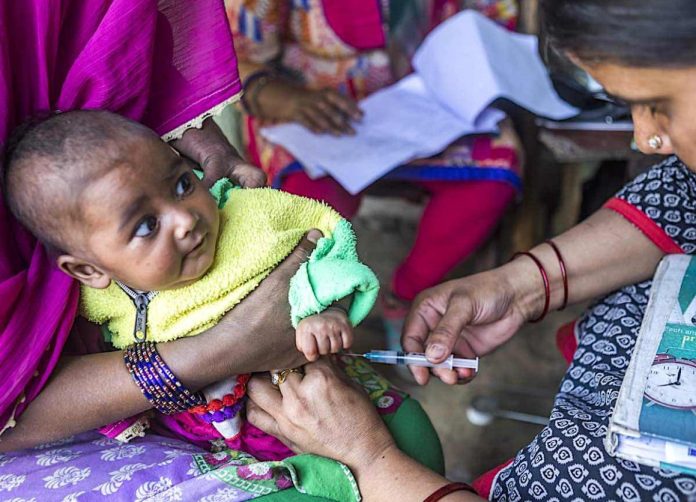
“United Nations Day”: An Exclusive Interview with UNICEF field warrior on immunizing India’s children, village by village
Date:

Share post:
Although India is a leading patron and exporter of vaccines, the country is home to one-third of the world’s unimmunized children. Smaller than 44 percent of India’s youthful children admit the full schedule of immunizations. India’s vaccine deficiency has several causes such as frugal investment by the government; a focus on polio eradication at the expenditure of other immunizations; and low demand as a consequence of an inadequately educated population and the presence of several anti-vaccine supporters.
In this story, a UNICEF officer who is a Social Mobilization Coordinator (on the condition of anonymity) handling the Siwan district of Bihar, sheds some light on the undying efforts of the UNICEF in alignment with the W.H.O immunization agenda, the stumbling blocks plaguing the system and what remedies can be introduced in order to strengthen national immunization programs.

Immunization Programs: An Introduction
“India has seen tremendous progress in immunization programs through its Mission Indradhanush program ( now Boosted Mission Indradhanush-IMI), targeting 27 million newborns and 29 million pregnant women annually. Notwithstanding the above figures, contagious conditions continue to contribute to a significant proportion of child mortality and morbidity in India”, says the UN officer.
He adds that these are the primary problems obstructing progress at the ground level:
- inequality in vaccine administration amongst the group of vulnerable children
- socioeconomic status-based vaccine disparity that leaves out the underprivileged and backward groups
“A more targeted approach is needed to overcome the case of inequality in vaccine administration”
The Curious Case of Vaccine Hesitancy: A field-level finding
Why is India hesitant to vaccinate their children?
This is a question that can be best answered by ground-level workers who actively participate in people problems like mobilization officers. Active participation in people problems, close interaction, conducting focussed group discussions, one-to-one
conversations can bring to the surface the numerous causes behind vaccine
hesitancy.

Factors that contribute to vaccine hesitancy:
- Parents’ Literacy: This is a direct parameter that affects the levels of vaccination in a village/district.
“There were villages where we found that parents had not even heard of immunization”
- Parents’ Income Levels
- Knowledge on the Vaccine schedule
- False Beliefs: This is by far the biggest impediment to immunization programs which are being implemented in India’s rural lands.
“Even some of the most affluent and educated families in villages believe that immunization will harm their children are they can do without it, it’s a grave danger”
The coronavirus pandemic has seen the rise of vaccine hesitancy amongst the educated and privileged as well due to a proliferation in misinformation. An analysis of the IMI has shown that lack of skills and sufficient time is the crucial limiting factor on the capabilities of community health workers in furnishing effective results. It suggests furnishing clear, accurate information to fight misinformation and myths around vaccination.
“Lack of skills and inadequate time is the key limiting factors on the capabilities of community health workers in providing effective counseling”.

The Need of the Hour:
A systematic approach to bridge the immunization gap with a robust and resilient health system to address the immunization challenge and equitable rollout of vaccines is an absolute need of the hour. Improving equitable access to immunization is critical to achieving the Sustainable Development Goals. There is an urgent need to make efforts to restore the routine immunization program immediately with all precautionary measures as per WHO guidelines.
On the ground, the mobilization team adopts a number of unique measures to influence and sensitize people. With changing times, old tricks won’t suffice.
“Sometimes blaring speakers screaming out vaccination schedule and timings don’t work. As a social mobilization coordinator, it’s my role to find out methods that work. So sometimes we perform nukkad nataks in villages highlighting the importance of immunization to prevent serious disabilities. These seem to catch people’s fancy and once they are curious they begin finding out more information on the same.
We have to keep innovating in our approach to get results. We try to appoint a head mobilizer for every village who oversees vaccination drives and weeds out false beliefs out of the minds of people.” says the SMC.
How can India’s citizens contribute to the immunization drive?
Confidence-building measures through clear and effective communication will be crucial for communities to feel safe and secure when they come forward for vaccination drives.
“If educated people affiliated to NGOs and other civil society or developmental organizations, can come forward to bust the myth that the poor, underprivileged people have regarding vaccine shots, it will go a long way in breaking the chain of unawareness”, he emotionally adds.

Conclusion:
UNICEF’s strategy of conducting catch-up campaigns in high-burden, high-priority districts, followed by routine immunizations, goes in line with the World Health Organization’s recommendations.
“Our field teams are constantly monitoring the Village Health and Nutrition Days for routine immunization activities. We are ensuring that new guidelines are abided by and that health workers and beneficiaries take all precautions and protective steps”, the officer maintains.
“Sometimes it gets hectic on the field, starting the day with field visits to countless villages and ending the day with compiling reports for the entire district. But people are supportive and when they thank us for our efforts, the entire effort feels so satisfying”, he adds.
Social Mobilization Coordinators are the face of international bodies like UNICEF who travel the field in search of ground realities bearing the brunt of unprecedented obstacles. They literally walk and talk about people’s developmental problems.
It is our duty as netizens of the country to support them with whatever we can so each village can be a model village with 100% immunization. Let’s immunize India’s villages, infant by infant! Let’s be DOERS!
